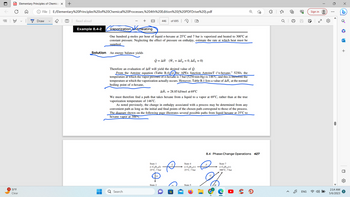
Introduction to Chemical Engineering Thermodynamics
8th Edition
ISBN: 9781259696527
Author: J.M. Smith Termodinamica en ingenieria quimica, Hendrick C Van Ness, Michael Abbott, Mark Swihart
Publisher: McGraw-Hill Education
expand_more
expand_more
format_list_bulleted
Question
I need help solving this problem.

Transcribed Image Text:1 51°F
Clear
Elementary Principles of Chemica X +
File | E:/Elementary%20Principles%20of%20Chemical%20Processes,%204th%20Edition%20(%20PDF Drive%20).pdf
Draw
(T)
Read aloud
Example 8.4-2
Solution
An energy balance yields
←→
Vaporization and Heating
One hundred g-moles per hour of liquid n-hexane at 25°C and 7 bar is vaporized and heated to 300°C at
constant pressure. Neglecting the effect of pressure on enthalpy, estimate the rate at which heat must be
supplied.
Q Search
446 of 695
Q =ΔΗ (W, = ΔΕ, = 0, ΔΕ, ~ 0)
Therefore an evaluation of AH will yield the desired value of Q.
From the Antoine equation (Table B.4) or the APEx function AntoineT (“n-hexane,” 5250), the
temperature at which the vapor pressure of n-hexafe is 7 bar (5250 mm Hg) is 146°C, and this is therefore the
temperature at which the vaporization actually occurs. However, Table B.1 lists a value of AĤ, at the normal
boiling point of n-hexane,
AĤ = 28.85 kJ/mol at 69°C
We must therefore find a path that takes hexane from a liquid to a vapor at 69°C, rather than at the true
vaporization temperature of 146°C.
As noted previously, the change in enthalpy associated with a process may be determined from any
convenient path as long as the initial and final points of the chosen path correspond to those of the process.
The diagram shown on the following page illustrates several possible paths from liquid hexane at 25°C to
hexane vapor at 300°C.
State 1
n-C6H₁4(1)
25°C, 7 bar
State 2
ETA
H
State 4
n-C6H₁4(v)
25°C, 7 bar
State 5
8.4 Phase-Change Operations 427
State 7
n-C6H₁4(v)
300°C, 7 bar
I
<
Ơ
re
80
J
VENG
Sign in
2:14 AM
5/6/2023
•
la
+
O
Expert Solution
This question has been solved!
Explore an expertly crafted, step-by-step solution for a thorough understanding of key concepts.
This is a popular solution
Trending nowThis is a popular solution!
Step by stepSolved in 3 steps with 2 images

Knowledge Booster
Similar questions
- in text form with proper workings and explanation for each and every part and steps with concept and introduction no AI no copy paste remember answer must be in proper format with all working!!!!!!!arrow_forwardStuck need help! Problem is attached. please view attachment before answering. Really struggling with this concept. Please show all work so I can better understand ! Thank you so much.arrow_forwardBen tested a coin to see if it was fair. He got 38 Heads and 62 Tails. What is the relative frequency of the coin landing on heads? Give your answer in decimal format. Answer:arrow_forward
- what's the answer in m^3?arrow_forwardUsing the data below, construct a calibration curve. Include the error bars and the equation of the line and the linearity (R2) of the curve. Calcium concentration (ppm) (X-data) Absorbance (Y-data) Run 1 Absorbance (Y-data) Run 2 Absorbance (Y-data) Run 3 0.3 1109 1069 1155 1.2 1225 1168 1233 2.1 1472 1319 1389 4.2 1497 1523 1472 8.0 1833 1898 1849 16 2066 2012 2051arrow_forwardWhat are the company/ies that handled the petroleum resources in the Philippines?arrow_forward
arrow_back_ios
arrow_forward_ios
Recommended textbooks for you
 Introduction to Chemical Engineering Thermodynami...Chemical EngineeringISBN:9781259696527Author:J.M. Smith Termodinamica en ingenieria quimica, Hendrick C Van Ness, Michael Abbott, Mark SwihartPublisher:McGraw-Hill Education
Introduction to Chemical Engineering Thermodynami...Chemical EngineeringISBN:9781259696527Author:J.M. Smith Termodinamica en ingenieria quimica, Hendrick C Van Ness, Michael Abbott, Mark SwihartPublisher:McGraw-Hill Education Elementary Principles of Chemical Processes, Bind...Chemical EngineeringISBN:9781118431221Author:Richard M. Felder, Ronald W. Rousseau, Lisa G. BullardPublisher:WILEY
Elementary Principles of Chemical Processes, Bind...Chemical EngineeringISBN:9781118431221Author:Richard M. Felder, Ronald W. Rousseau, Lisa G. BullardPublisher:WILEY Elements of Chemical Reaction Engineering (5th Ed...Chemical EngineeringISBN:9780133887518Author:H. Scott FoglerPublisher:Prentice Hall
Elements of Chemical Reaction Engineering (5th Ed...Chemical EngineeringISBN:9780133887518Author:H. Scott FoglerPublisher:Prentice Hall
 Industrial Plastics: Theory and ApplicationsChemical EngineeringISBN:9781285061238Author:Lokensgard, ErikPublisher:Delmar Cengage Learning
Industrial Plastics: Theory and ApplicationsChemical EngineeringISBN:9781285061238Author:Lokensgard, ErikPublisher:Delmar Cengage Learning Unit Operations of Chemical EngineeringChemical EngineeringISBN:9780072848236Author:Warren McCabe, Julian C. Smith, Peter HarriottPublisher:McGraw-Hill Companies, The
Unit Operations of Chemical EngineeringChemical EngineeringISBN:9780072848236Author:Warren McCabe, Julian C. Smith, Peter HarriottPublisher:McGraw-Hill Companies, The

Introduction to Chemical Engineering Thermodynami...
Chemical Engineering
ISBN:9781259696527
Author:J.M. Smith Termodinamica en ingenieria quimica, Hendrick C Van Ness, Michael Abbott, Mark Swihart
Publisher:McGraw-Hill Education

Elementary Principles of Chemical Processes, Bind...
Chemical Engineering
ISBN:9781118431221
Author:Richard M. Felder, Ronald W. Rousseau, Lisa G. Bullard
Publisher:WILEY

Elements of Chemical Reaction Engineering (5th Ed...
Chemical Engineering
ISBN:9780133887518
Author:H. Scott Fogler
Publisher:Prentice Hall


Industrial Plastics: Theory and Applications
Chemical Engineering
ISBN:9781285061238
Author:Lokensgard, Erik
Publisher:Delmar Cengage Learning

Unit Operations of Chemical Engineering
Chemical Engineering
ISBN:9780072848236
Author:Warren McCabe, Julian C. Smith, Peter Harriott
Publisher:McGraw-Hill Companies, The